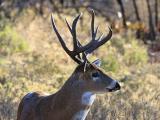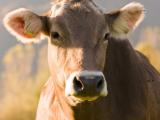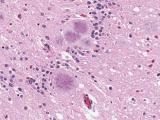Jul 5, 2005 (CIDRAP News) Canada yesterday confirmed its sixth case of bovine spongiform encephalopathy (BSE), or mad cow disease.
The case was found in a mature cross-bred cow from Manitoba, the Canadian Food Inspection Agency (CFIA) said. The disease was detected through Canada's ongoing surveillance program, and no part of the animal's carcass entered the human food or animal feed systems, the CFIA said. The agency had announced the discovery of a potential case on Jun 30.
In an investigation, CFIA officials determined that the owner purchased the cow in 1992 "as part of an assembled group of cattle," the agency said. This means that the animal was at least 15 years old and was born well before the 1997 start of Canada's ban on feeding rendered cattle protein to cattle and other ruminant animals, officials said.
The CFIA said investigators are attempting to locate the animal's birth farm, which will help identify herd mates and the feed it was exposed to at an early age. "Given the animal's age, investigative efforts may be constrained by few surviving animals and limited sources of information, such as detailed records," the agency said. A calf born to the affected cow in 2004 is also being traced.
The US Department of Agriculture (USDA) has not announced any new restrictions on importation of Canadian cattle or beef in the wake of the new BSE case. USDA spokesperson Ed Loyd told the Associated Press last week that US officials have a high degree of confidence in the BSE safeguards used in the US and Canada.
The United States banned Canadian cattle and beef imports after Canada's first BSE case was found in May 2003. In August 2003 the USDA loosened the ban to allow imports of boneless beef from cattle less than 30 months old. In July 2005, the agency reopened the border to live Canadian cattle intended for slaughter before reaching the age of 30 months.
On the other side of the border, the CFIA announced on Jun 29 that Canada was opening its border to a broader range of US animals and animal products. All classes of US cattle, including those used for breeding that were born after 1999, are eligible for entry based on certification requirements. Beef from cattle over 30 months of age will be eligible for import under certain conditions.
Confirmation of the new BSE case came less than 2 weeks after the CFIA announced a strengthening of its BSE-related feed restrictions. The new rule, to take effect in 2007, bans the use of high-risk cattle parts, called specified risk materials, in all animal feeds, pet foods, and fertilizers. The CFIA said including more products in the ban helps prevent contamination of cattle feed during production, transportation, storage, and use. Removing the risky cattle tissues from pet food and fertilizers is also intended to address misuse of these products.
The CFIA has said that it expects to continue to find a few BSE cases, but that the expanded feed ban will hasten the eradication of the disease in Canada.
The US Food and Drug Administration is currently reviewing public comments on a proposal to broaden the US feed ban. The proposalmore limited than Canada's new ruleis to ban the use of older cattle's brains and spinal cords from all animal feeds and pet foods.
Canada's fifth BSE case, in a British Columbia dairy cow, was reported in April 2006. Humans who eat meat products from BSE-infected cattle are believed to be at risk for variant Creutzfeldt-Jakob disease (vCJD), the fatal human equivalent of BSE
See also:
Apr 17, 2006, CIDRAP News article on Canada's fifth BSE case
http://www.cidrap.umn.edu/cidrap/content/other/bse/news/apr1706cow.html
















